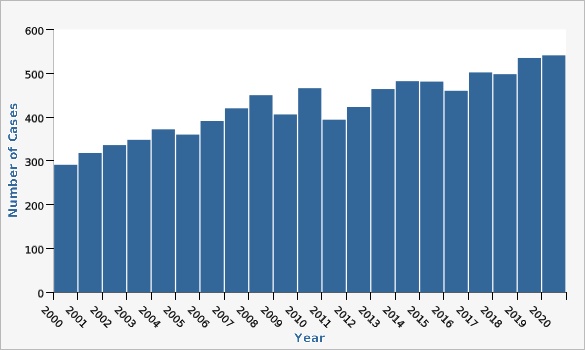Complete Health Indicator Report of Non-Hodgkin Lymphoma
Definition
The rate of non-Hodgkin lymphoma in Utah per 100,000 population.Numerator
The number of incidents of non-Hodgkin lymphoma among Utah population for a specific given time period (ICD-10: C82-C85).Denominator
Population of Utah for a specific period of time.Data Interpretation Issues
Incidence rates may vary from source to source. This may be due to having more or less updated information or using different population databases.Why Is This Important?
Non-Hodgkin lymphoma is cancer that starts in the lymphoid tissue. Non-Hodgkin lymphomas can occur at any age and are often marked by enlarged lymph nodes, fever, and weight loss. There are many different types of non-Hodgkin lymphoma, which can be divided into aggressive (fast-growing) and indolent (slow-growing) types and can be classified as either B-cell or T-cell non-Hodgkin lymphoma. Some risk factors for developing non-Hodgkin lymphoma are older age, exposure to certain chemicals such as benzene, certain pesticides and herbicides, radiation exposure, weakened immune system, autoimmune disease, certain infections such as HIV, and obesity.^1^ [[br]] [[br]] ---- 1. Non-Hodgkin Lymphoma Risk Factors. Cancer.org. [https://www.cancer.org/cancer/non-hodgkin-lymphoma/causes-risks-prevention/risk-factors.html]. Accessed December 19, 2019.How Do We Compare With the U.S.?
For years 2012-2016 (the most recent available data) the U.S. non-Hodgkin lymphoma cancer age-adjusted incidence rate was 19.2 per 100,000 compared with the Utah rate of 18.4 per 100,000.^2^[[br]] [[br]] ---- 2. National Cancer Institute. (2019). State Cancer Profiles: Utah. Accessed on January 14, 2020 from [https://statecancerprofiles.cancer.gov/quick-profiles/index.php?statename=utah].What Is Being Done?
The Utah Leukemia and Lymphoma Society offers many services to those affected by these cancers such as educational information, support groups, advocacy and volunteer opportunities, treatment options, and research information. For more information visit [https://www.lls.org/utah].Related Indicators
Related Relevant Population Characteristics Indicators:
Graphical Data Views
Non-Hodgkin Lymphoma Number of Cases by Year, Utah, 2000-2018

| Year | Number of Cases | |||||
|---|---|---|---|---|---|---|
Record Count: 19 | ||||||
| 2000 | 290 | |||||
| 2001 | 318 | |||||
| 2002 | 336 | |||||
| 2003 | 348 | |||||
| 2004 | 372 | |||||
| 2005 | 359 | |||||
| 2006 | 390 | |||||
| 2007 | 419 | |||||
| 2008 | 450 | |||||
| 2009 | 404 | |||||
| 2010 | 465 | |||||
| 2011 | 394 | |||||
| 2012 | 421 | |||||
| 2013 | 463 | |||||
| 2014 | 481 | |||||
| 2015 | 480 | |||||
| 2016 | 458 | |||||
| 2017 | 496 | |||||
| 2018 | 491 | |||||
Data Source
Cancer data provided by the Utah Cancer Registry, supported by the National Cancer Institute (HHSN261201800016I), the U.S. Center for Disease Control and Prevention (NU58DP0063200), the University of Utah, and Huntsman Cancer FoundationReferences and Community Resources
[http://www.cancer.gov/types/lymphoma National Cancer Institute - Lymphoma][[br]] [http://www.cancer.org/cancer/non-hodgkinlymphoma/ American Cancer Society - Non-Hodgkin's Lympoma][[br]] [http://www.mayoclinic.org/diseases-conditions/non-hodgkins-lymphoma/basics/definition/con-20027792 Mayo Clinic - Non-Hodgkin's Lymphoma][[br]]More Resources and Links
Evidence-based community health improvement ideas and interventions may be found at the following sites:- Centers for Disease Control and Prevention (CDC) WONDER Database, a system for disseminating public health data and information.
- United States Census Bureau data dashboard.
- Utah healthy Places Index, evidence-based and peer-reviewed tool, supports efforts to prioritize equitable community investments, develop critical programs and policies across the state, and much more.
- County Health Rankings
- Kaiser Family Foundation's StateHealthFacts.org
- Medical literature can be queried at PubMed library.
Page Content Updated On 04/08/2021,
Published on 01/14/2022
